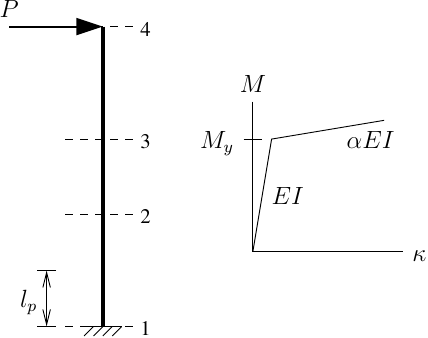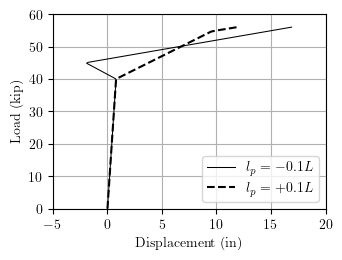OpenSees Cloud
OpenSees AMI
Integration Points with Negative Weight
Original Post - 03 Jul 2020 - Michael H. Scott
Show your support at Buy Me a Coffee.
A colleague in Eastchester once told me that faculty have three, maybe four, good ideas over their career. In other words, a faculty member could have over a hundred papers, but there’s only three or four underlying concepts. Perhaps it was “two, maybe three”, but you get the point.
Playing with integration points and weights, i.e., quadrature, in force-based frame finite elements is one of my good ideas. I’ve written a handful of papers on the subject, but there’s still a few loose ends. I don’t consider these loose ends to be LPUs because any article that tidies up a loose end would be 90% re-hash of previous work. A blog post is a much better outlet.
One such loose end is what happens to the computed response of a force-based frame element when one of the integration points has a negative integration weight. In a couple of those papers and in another post I did my best Mr. Mackey and wrote “negative integration weights are bad, m’kay”, but never showed why.
The reason why is encountering a negative integration weight is very unlikely if you don’t have any input errors. However, I’ve learned that anything is possible with nonlinear structural analysis in OpenSees, thanks to its numerous modeling choices and its free-range approach to error checking.
One way your model can have a negative integration weight is due to an input error when using plastic hinge integration. For example, your input script uses a Tcl or Python expression to compute a plastic hinge length, lp, in terms of concrete compressive strength, f’c, but f’c is defined as negative in order to appease the Concrete23 constructor.
The following example demonstrates the effect of a negative integration
weight. The model is an L=120 inch tall column with bilinear
moment-curvature response (EI=3x107 kip-inch2,
My=4800 kip-inch, \(\alpha\)=0.01) at each integration point.

The element integration rule is endpoint plastic hinge integration with lp=0.1L at the column base. This is not the best plastic hinge integration method, but it is a straightforward approach to show what happens when a plastic hinge length is negative.
The computed load-displacement response at the top of the column is shown below for the “input error” lp=-0.1L and the “intended” solution using lp=+0.1L.

There are other modeling approaches, summarized here, that can give
negative integration weights even with correct inputs, i.e., positive
plastic hinge lengths and a reasonable number of integration points:
- Modified Gauss-Radau plastic hinge integration where 4(lpI+lpJ) > L. The length of the elastic interior becomes negative, making the weights of the two interior integration points negative. This condition is pretty easy to achieve with correct inputs.
- Any other plastic hinge integration method where lpI+lpJ > L, for the same reason as the previous item. It would be difficult to satisfy this condition with correct inputs.
- Quadrature rules with prescribed integration point locations can have negative integration weights upon solving the Vandermonde equations.
- Newton-Cotes integration with an odd number of integration points, N>=9. For example, with N=9, integration points 3, 5, and 7 have negative weight.
These approaches lead to varying degrees of strange results, but are generally harmless because the negative integration weights are not at the ends of the element. However, there could be unexpected results with member loads.
If you see strange results when using force-based frame elements, a
negative weight could be the culprit, but it’s likely something else.
Regardless, it’s a good idea to use the
sectionWeight
command to check the integration weights.